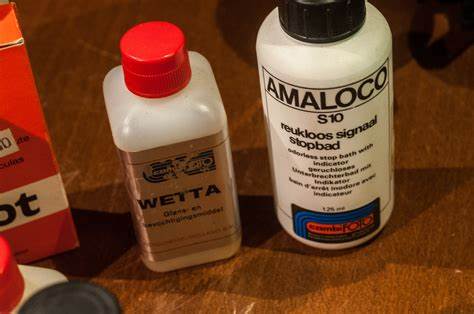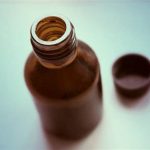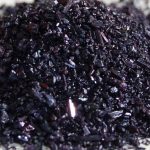Darkroom chemicals must be handled with care since they are potentially dangerous.
If any of these chemicals are left sitting around in your darkroom, they can affect the quality of your photos.
There are several ways you can safely dispose of these chemicals.
Let’s start now.
The Basic Darkroom Chemicals
Contents
Developer
When light hits photographic paper or film and bounces off of it onto the emulsion layer, a latent image is made.
When the reflected rays hit the silver halides in the emulsion, they change into tiny pieces of silver metal.
A latent picture can be made visible by developing it, which means taking the silver ions out of the exposed areas of the emulsion. This makes the picture more sensitive to light.
The developer does this by converting the silver ions that are in the exposed areas to insoluble metallic silver, which is less reflective than the rest of the film’s surface.
The new developer solution also oxidizes the unexposed areas of the emulsion to color them black or gray; this is called toning.
However, the developer darkens with usage and deteriorates over time, so it must be replaced regularly to keep the chemistry fresh.
Unmixed developer concentrate powder may be stored in its original packaging indefinitely as long as it is kept dry, in a cool place, away from strong light sources and heat.
After combining it with water to dilute it for use, the developer should be stored in the refrigerator and used within one week.
Stop Bath
A developer will continue to work until the developing agent has removed all of the soluble metallic silver from the exposed areas of the photo; once this happens, no more picture development can take place without additional exposure.
The Stop bath neutralizes the developer solution and prevents it from continuing to develop the picture any further.
Stop baths have a two-year unopened shelf life if stored in a cool, dark place away from heat; once opened, they should be discarded after six months and replaced with fresh stop baths.
Stop bath in liquid form isn’t too dangerous, but it does contain ammonia, which is a poisonous chemical that can cause serious damage to the eyes and skin if it gets in them or if a lot of it is breathed in.
Fixer
Even after you’ve snapped your picture and developed it in the darkroom, it is still not permanently fixed to the photo paper; you must fix the print to make it permanent using a fixer.
Fixers prohibit any discoloration of the print by dissolving the remaining undeveloped silver halides.
Fixer stabilizes the image by getting rid of any silver halides in the emulsion that haven’t been exposed. A final wash gets rid of any remaining fixer on the print.
Fixer also gets rid of any toning on the background of the photo that was caused by the stop bath and neutralizes any alkaline developer solution or fixer that was left behind.
Unopened fixers stored in an airtight container will survive indefinitely at room temperature; once opened, however, they must be discarded after three months and replaced with a fresh bottle.
Fixer is normally odorless, but if it has started to smell musty or sour, you should discard it immediately and replace it with a new bottle.
Precautions to Take When Working With Darkroom Chemicals
All of the above compounds can be used for different things, but they are not always safe to handle without the right training.
Before you touch any darkroom chemicals, you should learn about the safety precautions you should take to keep yourself and others from getting hurt.
This includes knowing how to store each type of chemical safely and effectively, as well as the right way to mix solutions and work with them when they are wet.
It is also critical to keep these chemicals out of the reach of children, as even small amounts of some substances can be fatal if ingested.
If any of these substances comes into contact with your skin or eyes, wash the area immediately with cold water and seek medical attention if necessary.
If you swallow any of these darkroom chemicals, call your local poison control center.
How to Dispose of Darkroom Chemicals
Locating a Waste Treatment Facility in Your Area
Waste treatment plants are very important to our community because they get rid of dangerous household chemicals and other dangerous waste that can’t be thrown away with regular trash.
You will be able to dispose of your darkroom chemicals in a safe manner and help keep our environment clean for future generations to enjoy.
Search for “Environmental Protection Agency home hazardous waste” in your area to find the closest facility to you.
Darkroom Chemical Disposal at a Treatment Facility
You will be able to get rid of your used chemical containers, rags, paper towels, etc.
Fixer, on the other hand, is non-recyclable, so you will need to dump it in the trash.
This implies that it can only contain waste material generated by the photographic industry.
To dispose of used fixers, contact your local waste treatment facility to find out what their requirements are for bringing in this type of waste.
Put the fixer into a bucket and pour water into it until the container is full; this should cover the fixer completely.
The steel wool pad will have absorbed the fixer and should be thrown out with the rest of the container.
The silver will have a sludge-like consistency, so pour it into a clean plastic trash bag and seal the bag tightly before placing it in the trash.
You can now throw away the rest of the liquid fixer solution with the rest of your trash.
It will be impossible to dispose of silver and other metals in your standard trash bins because these items are considered hazardous waste.
Home Disposal of Darkroom Chemicals
Only the developer and stop bath may be legally disposed of at home, but both of these items must be carefully stored and handled to prevent accidental spills or contamination from seeping into the ground or water systems.
Dilution is a critical step in disposing of both developer and stop bath safely at home.
Dilution is the process of making a chemical mixture less strong by mixing it with a solvent like water.
According to the researchers, mixing wasted developer and stop bath with water allows these materials to be diluted enough that they are no longer harmful to the environment.
This solution may then either be poured down the drain or flushed down the toilet.
Also Read: How to Dispose of Copper Sulfate Properly
Final Words
Disposing of old darkroom chemicals may seem difficult at first, but following the guidelines in this article will help you keep toxic chemicals out of landfills and out of our drinking water supplies.
Now that you know how to safely get rid of your old chemicals, you can develop your photos in peace.





